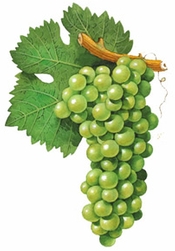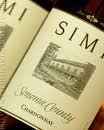|
|
 |
|
May 13, 2010
My WRO column for this month is all about Verdejo from Rueda, and I discovered last week that Rueda is now all about Verdejo. But this wasn’t always the case.
When I first visited the region a decade ago, Sauvignon Blanc was highly esteemed. Today, however, Sauvignon Blanc has become a rarity, with the vast majority of producers placing their bets on Verdejo. Even more striking is the fact that some winemakers who still work with Sauvignon have no enthusiasm for it at all, whereas others are actually willing to disparage it openly. Even more striking is the fact that some winemakers who still work with Sauvignon have no enthusiasm for it at all, whereas others are actually willing to disparage it openly.
This sort of near-total victory by a relatively obscure indigenous grape variety over a classic French cultivar with international renown is a genuine rarity--one approaching man-bites-dog proportions.
Here’s a bit of background. Winemaking in this region began with the Romans, and the Moors are widely credited with bringing Verdejo into the area. Palomino was also introduced in the modern era for making oxidized, Sherry-style wines, and these were predominantly what was produced during the first three-quarters of the 20th century, along with a little Verdejo and some Palomino-based table wines. Nobody shows any nostalgia for any of this stuff today, nor does anyone make any claims on behalf of its quality.
Modern viticulture and winemaking (based on temperature-controlled fermentation with a view toward fresh, un-oxidized wines) was first introduced to Rueda as late as the 1970s, initially by Rioja’s Marques de Riscal and that company’s famous consultant from Bordeaux, Emile Peynaud. Riscal ventured beyond Rioja in a white wine enterprise precisely because of the limitations of Rioja’s Viura grape, and that fact is sufficiently damning to enable us to dismiss Viura, which remains a minor player in the region.
(Riscal’s current technical director for the Rueda enterprise, Luis Hurtado de Amézaga Hamparzoumain, still blends 10% Viura into the Riscal Rueda bottling (as permitted by D.O. regulations), but picks it early to boost the acidity of the blend, and expects it to contribute nothing more profound than that.)
Fearing that the local Verdejo might not prove aromatically interesting enough to go it alone, Emile Peynaud advised planting Chardonnay (which didn’t catch on) and Sauvignon Blanc, which enjoyed some early success. As things have worked out, however, Verdejo has eclipsed Sauvignon so completely that some vintners now ridicule it openly--and I’m talking about vintners who are still in the business of bottling and selling it, and who are speaking on the record to a journalist.
Some winemakers simply regard Sauvignon as superfluous since Verdejo has panned out so nicely. Others shy from it based on a commercial strategy of keeping Rueda’s profile simple and straightforward rather than asking consumers around the world to think of it as a source for multiple varieties. Some think that it can make nice wine, but not wine that stands out from hundreds of other Sauvignons available from other regions around the world. Others, such as proprietor/winemaker Victoria Pariente make it simply because clients in certain markets want to have it--not because she has any particular regard for it by comparison to Verdejo. And still others, such as Riscal’s Luis Hurtado de Amézaga Hamparzoumain, express their displeasure with Sauvignon openly, noting its tendency to lose aroma when subject to heat.
Some producers, such as Juan de Benito Ozores of Alvarez Diez (maker of the Mantel Blanco brand), finish their Sauvignons with a noticeable smack of residual sugar. I can only describe this stylistic decision as extremely--um--surprising. I also tasted overtly sweet Sauvignons at Bodegas Antano and Bodega Hermanos de Villar, where the winemaker noted his displeasure with the variety when he initially tried to make it “In the Sauvignon style.” The rationale that was offered for leaving sweetness in the finish was that this was the only way to make something distinctive out of Sauvignon Blanc, by which I mean distinct from Verdejo as well as distinct from other Sauvignons crated elsewhere in the world.
You might wish to try one of these wines if you encounter them, but if you find them bizarre or distasteful, don’t say that I didn’t warn you. The only Sauvignon I tasted all week that I actually admired was the Montespina brand from Avelino Vegas, though the bottling from José Pariente was also quite solid.
Once regarded by the world’s most famous enologist as a bet-hedger against the shortcomings of Verdejo, Sauvignon Blanc is now down on the canvas and barely registering a pulse in Rueda. So if you needed an additional reason to try a Rueda wine made from the Verdejo grape, you can add a credit as “Giant Killer” to your list.
Posted by Michael Franz at 11:14 AM
|
|
May 5, 2010
Chardonnay just can't seem to get any respect these days. The darling white wines of the day are Riesling, Gruner Veltliner, Albarino, Rueda, Pinot Gris, et al. Lovely wines, indeed, and I certainly drink my share of them.
 Yet Chardonnay continues to be the No. 1 selling white wine in the United States. It's not all bad, people! In fact, quite a bit of it is pretty damn good. And you don't necessarily have to shell out the big bucks to get a decent bottle, though you could twist my arm to drink any one of those delicious (and a bit expensive) Patz & Hall vineyard-deisgnated Chards! Yet Chardonnay continues to be the No. 1 selling white wine in the United States. It's not all bad, people! In fact, quite a bit of it is pretty damn good. And you don't necessarily have to shell out the big bucks to get a decent bottle, though you could twist my arm to drink any one of those delicious (and a bit expensive) Patz & Hall vineyard-deisgnated Chards!
But I digress. In my Creators Syndicate column this week I offer up what I think are 10 very decent Chardonnays for $20 or less. The list is below, but the full column is available here!
1. Eberle 2008 Chardonnay, Paso Robles ($20)
2. Gloria Ferrer 2007 Chardonnay, Carneros ($18)
3. Ventana Vineyards 2008 Chardonnay, Monterey ($18)
4. Bogle 2008 Chardonnay, California ($9)
5. Hayman & Hill 2008 ‘Reserve Selection’ Chardonnay, Russian River Valley ($15)
6. Husch 2008 Chardonnay, Mendocino ($18)
7. Estancia 2008 ‘Pinnacles Ranches’ Chardonnay, Monterey ($12)
8. Simi 2008 Chardonnay, Sonoma County ($18)
9. Woodbridge 2008 Chardonnay, California ($11)
10. Eola Hills 2008 Chardonnay, Oregon ($10)
Posted by Robert Whitley at 10:33 AM
|
|
May 1, 2010
 April 30, 2010 I lost a great friend. And a great winemaker. Alfredo Currado, husband of Luciana Vietti, and father of current Vietti winemaker Luca Currado, succumbed to pneumonia after a twelve-year struggle with Parkinson’s Disease. April 30, 2010 I lost a great friend. And a great winemaker. Alfredo Currado, husband of Luciana Vietti, and father of current Vietti winemaker Luca Currado, succumbed to pneumonia after a twelve-year struggle with Parkinson’s Disease.
I first met Alfredo in 1981. Mary (now my wife) and I had just met that year, and we decided to visit Piedmont that fall, where we first met Alfredo and Luciana and their three children. The youngest one, 12-year-old Luca, was destined to be the winemaker, but we didn’t have a clue at the time. He was just a shy young boy then.
With the years, we bonded closely with the Vietti/Currado family. Not only did we love their wines, but we also loved the family. We spent many important occasions with them: Easter Sunday; weddings (Luca’s); funerals (Alfredo’s mother); grandchildren’s christenings; summer holidays on the Italian Riviera; and our favorite, holidays—both summer and winters, in Pontechianale, a village in the Italian Alps, bordering France.
 I vividly remember hiking in those Italian Alps with Alfredo and Luciana. He was so strong. Despite the fact that he was the oldest in our group, Alfredo was the fastest hiking up the mountain, even with the heaviest backpack, loaded with his wines, salami, cheeses, tins of Italian tuna, and fresh bread. A mountain goat, we called him! I vividly remember hiking in those Italian Alps with Alfredo and Luciana. He was so strong. Despite the fact that he was the oldest in our group, Alfredo was the fastest hiking up the mountain, even with the heaviest backpack, loaded with his wines, salami, cheeses, tins of Italian tuna, and fresh bread. A mountain goat, we called him!
Vietti always made great Barolo wines, especially the Rocche Vineyard (always Alfredo’s favorite) and his Villero Riserva. Alfredo made the 1996 Barolos; those two will remain as part of his legacy. Luca gradually took over as winemaker in 1998-00, and Alfredo’s illness slowly took charge of his life.
Vietti’s Barberas are state-of-the-art. I think that its Barbera d’Asti La Crena, along with the Vietti home vineyard, Barbera d’Alba Scarrone (especially the old vineyard, Vigna Vecchia) are as good as Barbera can be.
Good-bye, old friend. I love you, and I will miss you.
Posted by Ed McCarthy at 8:44 AM
|
|
 |
|